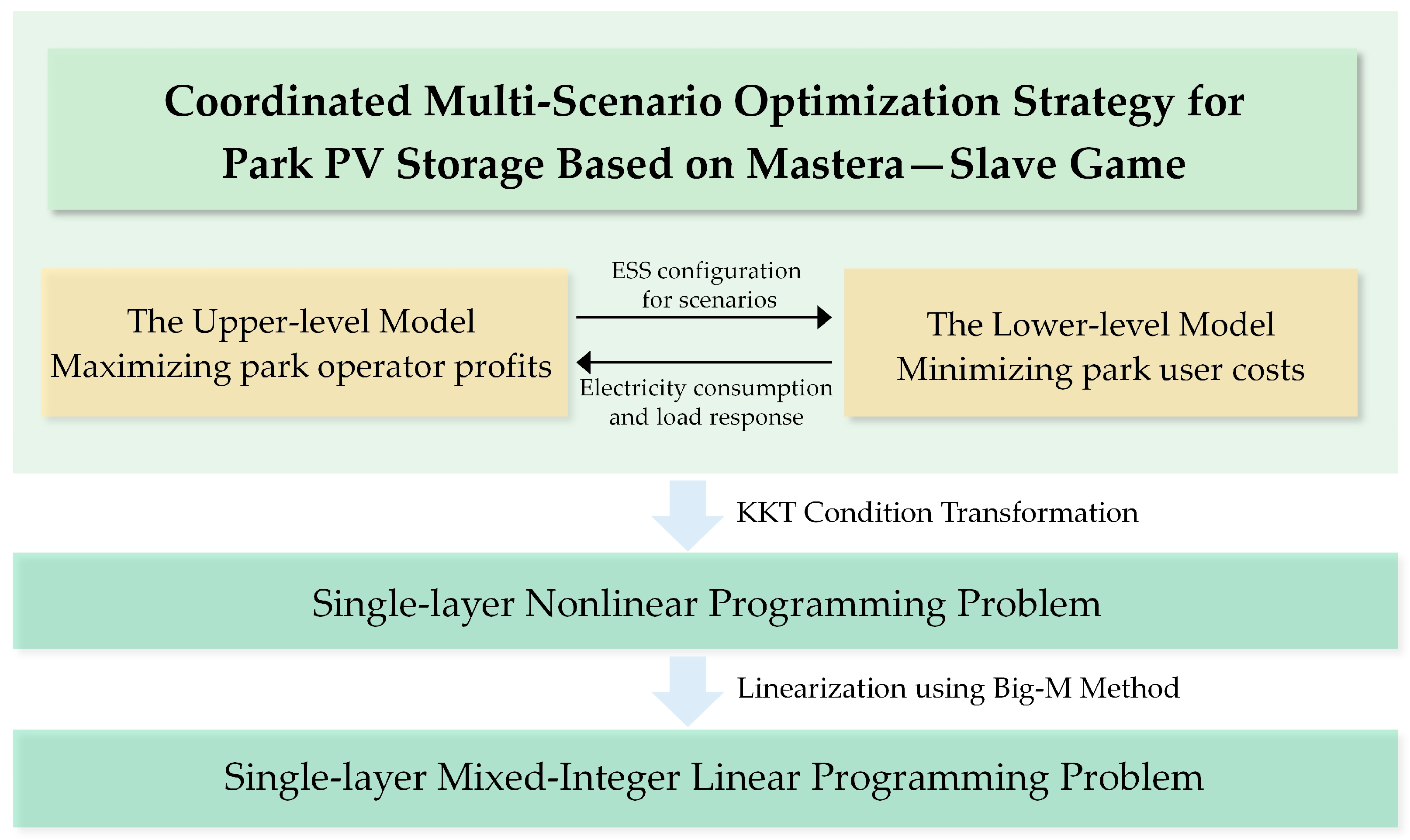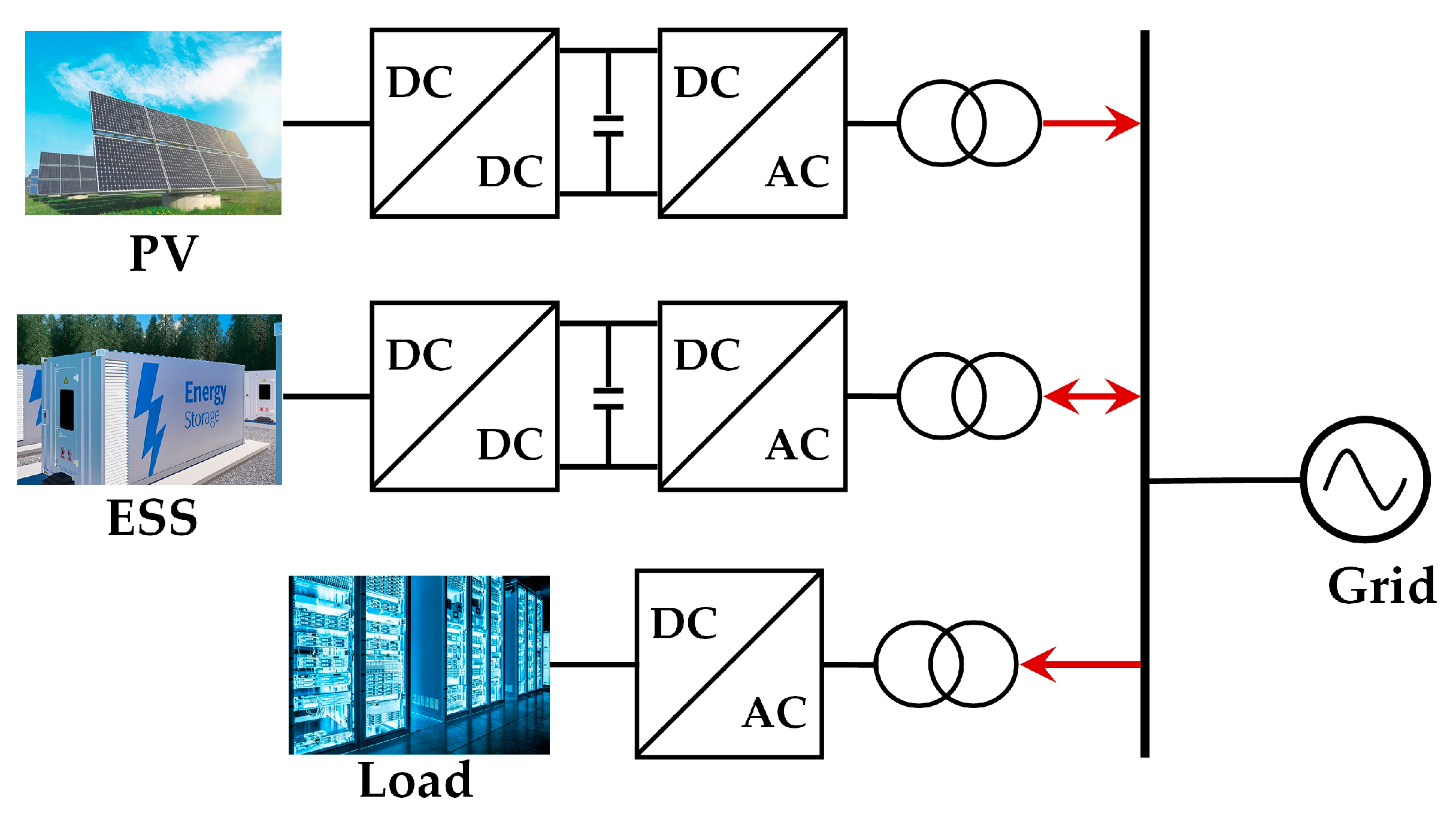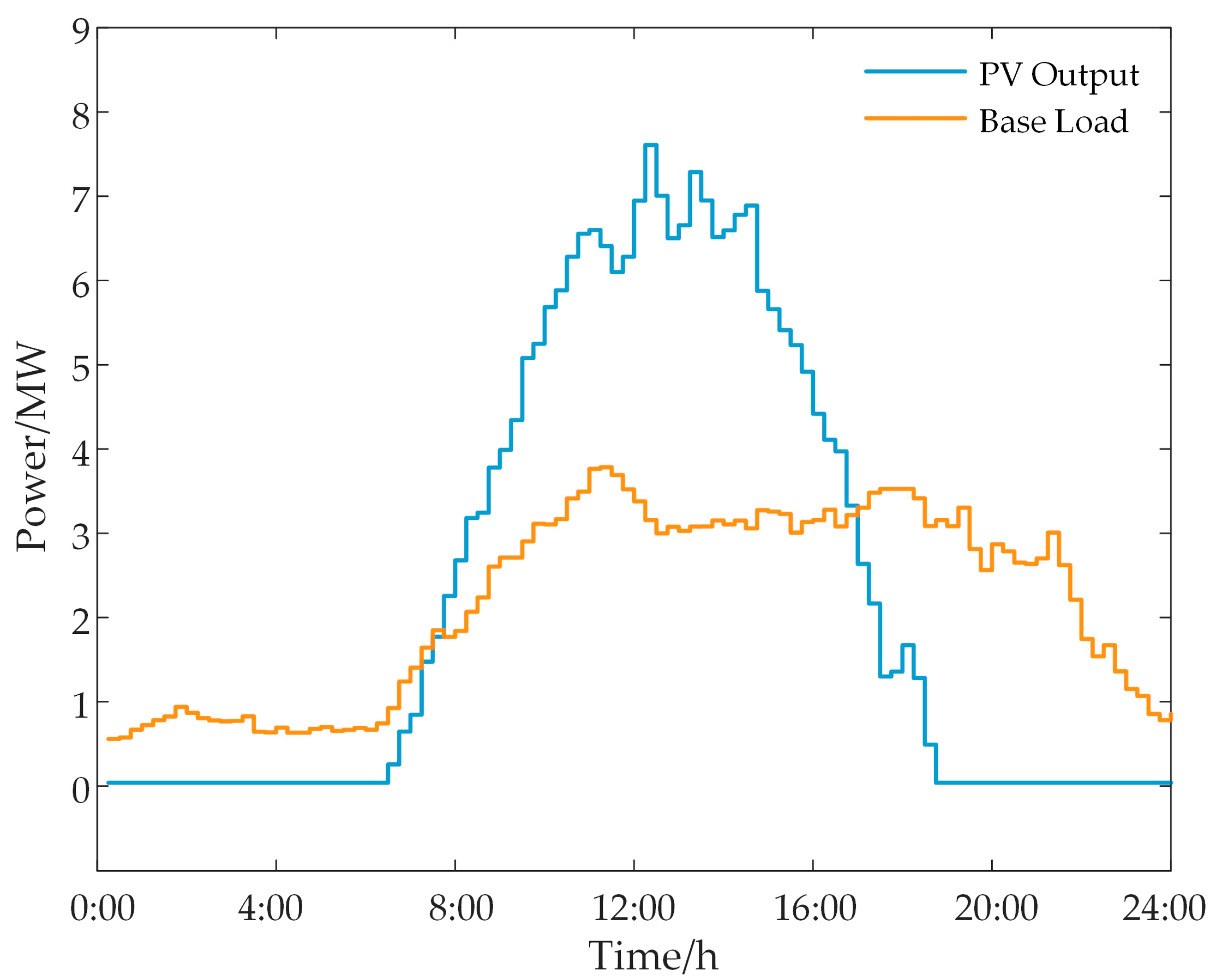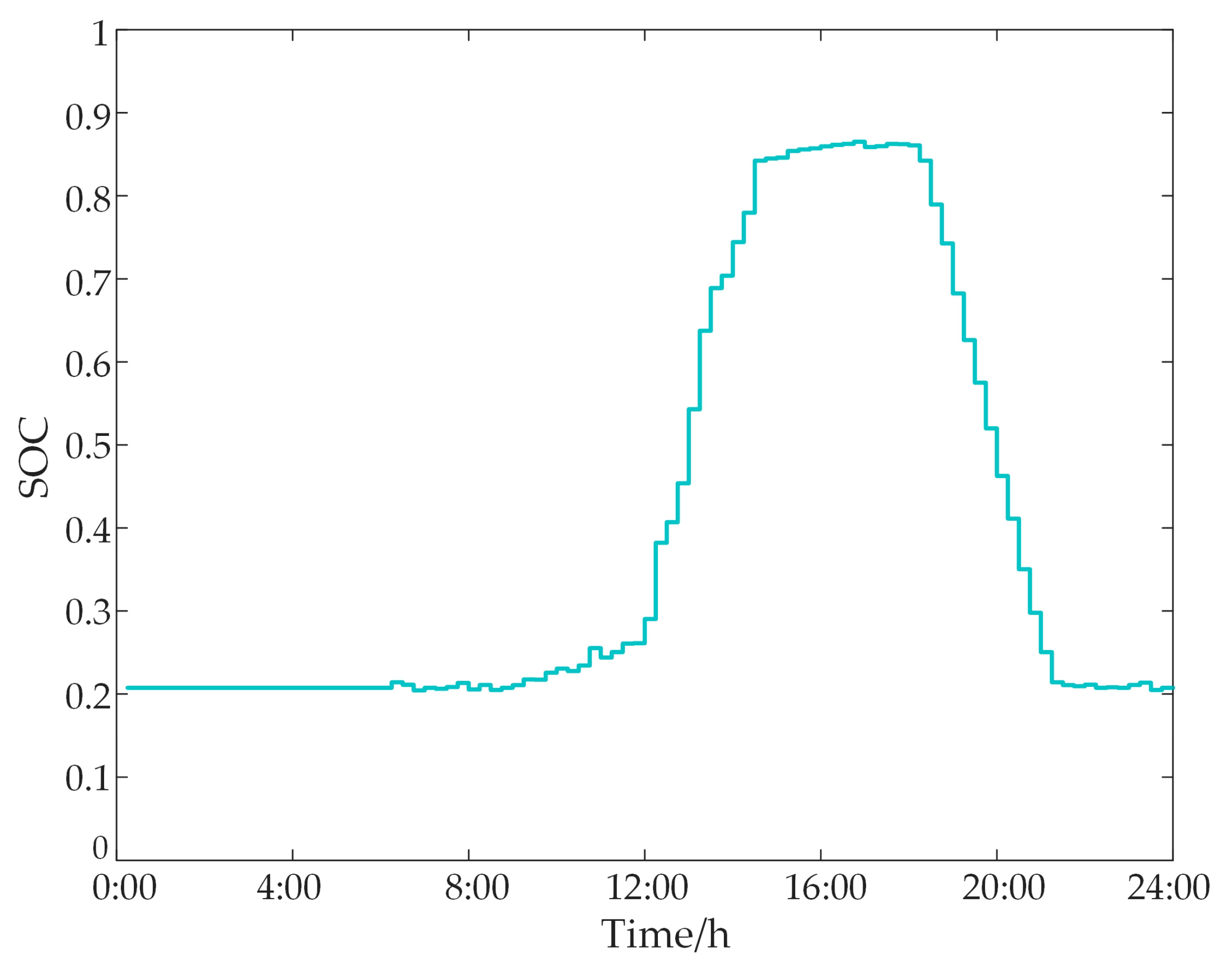Coordinated Multi-Scenario Optimization Strategy for Park Photovoltaic Storage Based on Master–Slave Game
Abstract
:1. Introduction
- Propose a multi-scenario collaborative optimization strategy for the operation of PV storage in parks, including smoothing photovoltaic fluctuations, load transfer compensation, and participation in the frequency regulation market, comprehensively summarizing the economic benefit model for the park.
- Establish a master–slave game model for the joint operation of PVs and ESSs in parks, with the upper-level goal of maximizing operator benefits and the lower-level goal of minimizing user power supply costs, achieving the optimization solution of the dual-level model.
- Present case studies validating the proposed optimization strategy, demonstrating a 25.8% increase in the economic benefits for park operators, a 5.27% reduction in user electricity expenses, and a decrease in the photovoltaic power curtailment rate to 1.478%. These results significantly enhance the overall economic efficiency of the park and the utilization efficiency of photovoltaic energy.
2. Multi-Application Scenarios for PV Storage Parks
2.1. Energy Storage Smoothing of PV Fluctuations
2.2. Energy Storage Participating in Energy Shifting
2.3. Energy Storage Participating in Frequency Regulation Market
2.4. Economic Benefit Model of Park Area
3. Dual-Layer Optimization Model for Integrated Operation of PV and ESS in Parks
3.1. Optimization Model for Upper-Level Park Operators
3.1.1. Objective Function
3.1.2. Constraint Condition
3.2. Optimization Model for Lower-Level Park Users
3.2.1. Objective Function
3.2.2. Constraint Condition
3.3. Model Solving
4. Case Study
4.1. Case Introduction
4.2. Case Analysis
4.2.1. Optimization Results
4.2.2. Objective Function of Upper-Level Model
5. Conclusions
- (i)
- The proposed multi-scenario collaborative optimization strategy for PV storage systems in parks analyzes and derives the principles of PV fluctuation smoothing, load transfer compensation, and participation in the frequency regulation market, further summarizing the economic benefit model of the park.
- (ii)
- The proposed master–slave game model for the joint operation of PV storage systems, based on the load response mechanism, reduces light abandonment. It increases frequency regulation market revenues and reduces electricity purchase expenditures, enhancing the economic benefits for park operators by 25.8% and effectively reducing user electricity costs by 5.27%, achieving better economic outcomes for both parties.
Author Contributions
Funding
Informed Consent Statement
Data Availability Statement
Conflicts of Interest
References
- Iheanetu, K.J. Solar Photovoltaic Power Forecasting: A Review. Sustainability 2022, 14, 17005. [Google Scholar] [CrossRef]
- Soares, I.V.; Mauger, R.; Santos, T. Considerations for benefit stacking policies in the EU electricity storage market. Energy Policy 2023, 172, 113333. [Google Scholar] [CrossRef]
- Akram, U.; Khalid, M. A Coordinated Frequency Regulation Framework Based on Hybrid Battery-Ultracapacitor Energy Storage Technologies. IEEE Access 2018, 6, 7310–7320. [Google Scholar] [CrossRef]
- Liu, Y.C.; Peng, M.F. Research on peak load shifting for hybrid energy system with wind power and energy storage based on situation awareness. J. Energy Storage 2024, 82, 110472. [Google Scholar] [CrossRef]
- Yi, H.; Yang, X. A metaheuristic algorithm based on simulated annealing for optimal sizing and techno-economic analysis of PV systems with multi-type of battery energy storage. Sustain. Energy Technol. Assess. 2022, 53, 102724. [Google Scholar] [CrossRef]
- Yang, Y.; Wang, Y.; Lu, Q.; Ruan, G.; Lin, Y.; Wang, X.; Xie, P.; Zhong, H. System value assessment method of energy storage system for multi-services of power system considering battery degradation. IET Energy Syst. Integr. 2023, 5, 355–364. [Google Scholar] [CrossRef]
- Yang, N.; Liang, J.; Ding, L.; Zhao, J.; Xin, P.; Jiang, J.; Li, Z. Integrated Optical Storage Charging Considering Reconstruction Expansion and Safety Efficiency Cost. Power Syst. Technol. 2023, 47, 3557–3567. [Google Scholar]
- Liu, H.T.; Zhai, R.R.; Patchigolla, K.; Turner, P.; Yu, X.H.; Wang, P. Multi-objective optimisation of a thermal-storage PV-CSP-wind hybrid power system in three operation modes. Energy 2023, 284, 129255. [Google Scholar] [CrossRef]
- Amorim, W.C.S.; Cupertino, A.F.; Pereira, H.A.; Mendes, V.F. On sizing of battery energy storage systems for PV plants power smoothing. Electr. Power Syst. Res. 2024, 229, 110114. [Google Scholar] [CrossRef]
- Abadi, S.; Bidram, A. A distributed rule-based power management strategy in a photovoltaic/hybrid energy storage based on an active compensation filtering technique. IET Renew. Power Gener. 2021, 15, 3688–3703. [Google Scholar] [CrossRef]
- Yu, Y.; Shahabi, L. Optimal infrastructure in microgrids with diverse uncertainties based on demand response, renewable energy sources and two-stage parallel optimization algorithm. Eng. Appl. Artif. Intell. 2023, 123, 106233. [Google Scholar] [CrossRef]
- Dong, H.; Wang, L.; Cao, Y.; Zheng, A.; Li, B.; Zeng, M. Capacity configuration and pricing designing method of PV-storage charging station considering user demand response. Acta Energiae Solaris Sin. 2021, 42, 79–86. [Google Scholar]
- Fan, X.; Ji, W.; Guo, L.; Gao, Z.; Chen, L.; Wang, J. Thermo-economic analysis of the integrated system of thermal power plant and liquid air energy storage. J. Energy Storage 2023, 57, 106233. [Google Scholar] [CrossRef]
- Liao, Y.; Li, Y.; Cai, J.; Liang, S. Investment benefit analysis of energy storage systems based on economic operation model. In Proceedings of the 6th International Conference on Intelligent Computing, Communication, and Devices, ICCD 2023, Hong Kong, China, 3–5 March 2023. [Google Scholar]
- Zhao, B.; Xu, Z.C.; Xu, C.; Wang, C.S.; Lin, F. Network Partition-Based Zonal Voltage Control for Distribution Networks with Distributed PV Systems. IEEE Trans. Smart Grid 2018, 9, 4087–4098. [Google Scholar] [CrossRef]
- Lin, Z.; Hu, Z.C.; Zhang, H.C.; Song, Y.H. Optimal ESS allocation in distribution network using accelerated generalised Benders decomposition. IET Gener. Transm. Distrib. 2019, 13, 2738–2746. [Google Scholar] [CrossRef]
- Liu, J.K.; Zhang, N.; Kang, C.Q.; Kirschen, D.; Xia, Q. Cloud energy storage for residential and small commercial consumers: A business case study. Appl. Energy 2017, 188, 226–236. [Google Scholar] [CrossRef]
- Zhang, L.; Zhang, T.; Zhang, K.; Hu, W. Research on power fluctuation strategy of hybrid energy storage to suppress wind-photovoltaic hybrid power system. Energy Rep. 2023, 10, 3166–3173. [Google Scholar] [CrossRef]
- Yu, Y.; Lu, W.; Chen, D.; Liu, M.; Xia, Y.; Zheng, X. Dynamic grouping control strategy for battery energy storage based on improved K-means under photovoltaic fluctuation suppression. Power Syst. Prot. Control 2024, 52, 1–11. [Google Scholar]
- Castro, L.M.; Espinoza-Trejo, D.R. Optimal placement of battery energy storage systems with energy time shift strategy in power networks with high penetration of photovoltaic plants. Sustain. Energy Grids Netw. 2023, 35, 101093. [Google Scholar] [CrossRef]
- Zhang, B.; Yang, J.; Tian, S.; Huang, Q.; Wang, W.; Sun, Q.; Ren, X. Techno-Economic Evaluation of a Compressed CO2 Energy Storage System for Load Shifting Based on Dynamic Modelling. Energies 2023, 16, 7894. [Google Scholar] [CrossRef]
- Chen, Z.; Tai, N.; Hu, Y.; Huang, W.; Li, L. A Multi-Objective Joint Planning of Transmission Channel and Energy Storage System Considering Economy and Flexibility. In Proceedings of the 16th IET International Conference on AC and DC Power Transmission, ACDC 2020, Virtual, Online, 2–3 July 2020; pp. 65–72. [Google Scholar]
- Li, Y.; Yao, T.; Qiao, X.; Xiao, J.; Cao, Y. Optimal Configuration of Distributed Photovoltaic and Energy Storage System Based on Joint Sequential Scenario and Source-Network-Load Coordination. Trans. China Electrotech. Soc. 2022, 37, 3289–3303. [Google Scholar]
- Sun, H.P.; Ding, X.H.; Wu, Z.; Xu, Z. Voltage Regulation Strategy of Distribution Network Considering Optimization Adjustment of Automatic Voltage Control System Limits. Autom. Electr. Power Syst. 2024, 1, 1–13. [Google Scholar]
- Cai, C.; Li, Y.; He, Y.; Guo, L. Two-tier coordinated optimal scheduling of wind/PV/hydropower and storage systems based on generative adversarial network scene generation. Front. Energy Res. 2023, 11. [Google Scholar] [CrossRef]
- Wang, Y.; Huang, C.; Wang, C.; Li, K.; Fang, X.; Yan, G. Optimal Configuration of Shared Energy Storage in Industrial Park Considering Full-cycle Economic Benefits in Electricity Market Environment. Autom. Electr. Power Syst. 2024, 48, 129–138. [Google Scholar]
- Jhala, K.; Natarajan, B.; Pahwa, A. Probabilistic Voltage Sensitivity Analysis (PVSA)-A Novel Approach to Quantify Impact of Active Consumers. IEEE Trans. Power Syst. 2018, 33, 2518–2527. [Google Scholar] [CrossRef]
- Chen, H.; He, C.; Zhang, R.; Jiang, T.; Li, X. Bi-level Optimization of Strategic Energy Management for Industrial Park Microgrid Participating in Distribution Market. Power Syst. Technol. 2023, 47, 2671–2681. [Google Scholar]
- Wand, Z.; Jia, Y.; Li, Y.; Han, X. Optimal Capacity Configuration of Photovoltaic and Energy Storage System in Active Distribution Network Considering Influence of Power Quality. Power Syst. Technol. 2024, 48, 607–617. [Google Scholar]
- Yang, S.; Tan, Z.; Zhou, J.; Xue, F.; Gao, H.; Lin, H.; Zhou, F. A two-level game optimal dispatching model for the park integrated energy system considering Stackelberg and cooperative games. Int. J. Electr. Power Energy Syst. 2021, 130, 106959. [Google Scholar] [CrossRef]
- Fang, Y.; Fan, R.; Liu, Z. A study on the energy storage scenarios design and the business model analysis for a zero-carbon big data industrial park from the perspective of source-grid-load-storage collaboration. Energy Rep. 2023, 9, 2054–2068. [Google Scholar] [CrossRef]
- de Souza, C.A.; da Silva, D.J.; Rossoni, P.; Belati, E.A.; Pelizari, A.; López-Lezama, J.M.; Muñoz-Galeano, N. Multi-Period Optimal Power Flow with Photovoltaic Generation Considering Optimized Power Factor Control. Sustainability 2023, 15, 14334. [Google Scholar] [CrossRef]











| Parameter | Parameter Values |
|---|---|
| // | 50/120/140 |
| / | 800/1800 |
| / | 0.95/0.95 |
| SOCmax/ SOCmin | 0.9/0.1 |
| / | 5/10 |
| Scenario | Operating Revenue /Yuan | User Expenditure /Yuan | Abandoned PV Energy /MWh |
|---|---|---|---|
| introducing load response | 32,460.75 | 34,893.26 | 0.386 |
| participating in frequency regulation | 38,526.42 | 36,456.24 | 4.237 |
| multiple application scenarios in this paper | 40,831.56 | 34,534.67 | 0.813 |
Disclaimer/Publisher’s Note: The statements, opinions and data contained in all publications are solely those of the individual author(s) and contributor(s) and not of MDPI and/or the editor(s). MDPI and/or the editor(s) disclaim responsibility for any injury to people or property resulting from any ideas, methods, instructions or products referred to in the content. |
© 2024 by the authors. Licensee MDPI, Basel, Switzerland. This article is an open access article distributed under the terms and conditions of the Creative Commons Attribution (CC BY) license (https://creativecommons.org/licenses/by/4.0/).
Share and Cite
Wang, J.; Lan, J.; Wang, L.; Lin, Y.; Hao, M.; Zhang, Y.; Xiang, Y.; Qin, L. Coordinated Multi-Scenario Optimization Strategy for Park Photovoltaic Storage Based on Master–Slave Game. Sensors 2024, 24, 5042. https://doi.org/10.3390/s24155042
Wang J, Lan J, Wang L, Lin Y, Hao M, Zhang Y, Xiang Y, Qin L. Coordinated Multi-Scenario Optimization Strategy for Park Photovoltaic Storage Based on Master–Slave Game. Sensors. 2024; 24(15):5042. https://doi.org/10.3390/s24155042
Chicago/Turabian StyleWang, Jiang, Jinchen Lan, Lianhui Wang, Yan Lin, Meimei Hao, Yan Zhang, Yang Xiang, and Liang Qin. 2024. "Coordinated Multi-Scenario Optimization Strategy for Park Photovoltaic Storage Based on Master–Slave Game" Sensors 24, no. 15: 5042. https://doi.org/10.3390/s24155042





